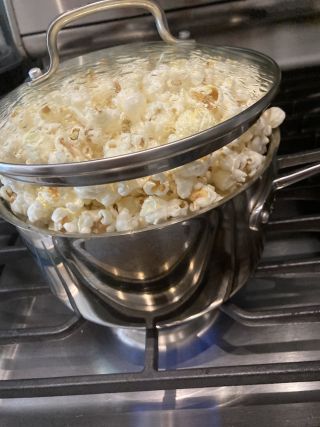Parenting
Fun Family Activities for Summer Downtime Moments
The connective properties of a simple popcorn recipe.
Updated June 30, 2023 Reviewed by Gary Drevitch

School is out. Summer’s here. Everyone’s excited.
Then it happens.
That first moment when there’s no camp, no travel, and no vacation. Everyone’s at home and we’re overwhelmed at the thought of how to keep our kids busy. Perhaps this feeling is even more accentuated by the temptation of screentime and the time filler it provides. All in moderation, like eating sugar or a delicious dessert.
Today’s post is dedicated to those of us parents who love summer vacation—but struggle with how to keep it all together during those downtime moments when nothing is going on.
How can we fill those long, sometimes very long, summer days with meaningful activities? How can we build connection in our collective free time?
Make slime. Recently, New York City, along with other parts of the country, was struck with sudden poor air quality from Canada’s wildfire smoke. The goal was to be safe and stay indoors. My best friend from college already had plans to visit and managed to make it to our doorstep. She was greeted with a slime festival.
“Grab some glue!” Olliver, age 7, said with exuberance.
“It’s really fun,” big sister Izzy, age 20, said as she jumped in.
Making slime is that great thing you can do to fill time with a fun activity. All you need is glue and a detergent activator. You can make it your own with food dye, little charms, foam beads, glitter glue, and a whole host of different slime ingredients.
That weekend I also learned that if you have a bunch of families over—by day 2, we needed to get out and get together—bringing out the slime supplies is a way for kids to play together while adults have a conversation.
Not only is slime a creative activity, it also promotes tactile learning and overall squishy fun.
Build your summer fund. Create a summer fund with coins found around the house, in your bag, and in random bowls. This activity even has Olliver searching all over the city for random change. Collect the coins and put them in a jar. We get assorted pre-formed coin tubes for pennies, nickels, dimes, and quarters.
When I’m making dinner or even if we have nothing planned for an afternoon, we can sit at the kitchen table sorting, organizing, and placing the coins in their respective tubes. This is great for learning about math, organization, and counting. It also supports fine motor skills: It’s not easy to get those coins in the tubes.
Once you have the tubes filled, you can take them to the bank to learn how much you have. It’s exciting to see the result and budget for that fun summer treat.
Read: Just add 10 minutes. Summer is an ideal time to work on building literacy skills. Research shows that just adding 10 minutes of reading each day provides greater exposure to the written word—so much so that just the extra 10 minutes can help decrease reading gaps (Adams, 2006).
Local libraries often have wonderful summer reading programs. This summer the library has a series of reading and community engagement activities for kids to do each week. At the end of the week, they get a prize and the activity sheet for the following week. This is so motivating for kids who are curious to see what the reward is as well as the subsequent activities. If your library doesn’t have a program, you can create your own, incorporating different activities each day.
Listening to audiobooks is another way to build literacy. In hearing the words and following them in the book, kids can build word recognition, vocabulary, and a growing sense of self-confidence related to reading.
Go thrift store shopping. Thrifting can be a wonderfully bonding experience with your preteen/teen. It all starts with picking the thrift store you plan to visit. Sorting through clothes and asking each other what works fosters communication and new understandings. Take a break and go for lunch, only to return to continue your search for hidden treasure. Thrift store shopping is good for the environment, good for your wallet, and good for the soul.
Declutter and donate. Summer is a great time to partner with your kids to declutter that closet, hallway, or their rooms. For kids of any age, you can work together to sort through and figure out what stays and what goes. When it comes to our kids’ stuff, we do this together, asking what they want to keep and what they don’t to avoid anything being accidentally thrown out. After decluttering, donate what you no longer need.
These are just a few ideas of things to do with family members during downtime summer moments. They can be built on and changed to fit the kinds of activities that work for your family. And of course, making homemade popcorn is a tasty complement to shared summertime fun—and our recipe has just three ingredients.
Here’s the recipe for The Most Amazing Popcorn from Eating Together, Being Together (Clauss-Ehlers & Clauss-Ehlers, 2022):
Ingredients
1 cup popcorn kernels
1/4 cup vegetable oil
Fine sea salt
Serves 8.
Pour the vegetable oil into a large saucepan and place over medium heat. As the oil heats, add just 2 or 3 kernels of popcorn and cover the pan with a lid. Listen. It will get surprisingly quiet just before you hear the kernels pop. Right after that happens, add the rest of the kernels and put the lid back on.
Here’s the trick: remove the pan from the heat for about 45 seconds (count down from 45 to 0 with your helpers). This will help all the kernels reach the same temperature to be able to POP at the same time. It also avoids burning the popcorn that has already popped. When your countdown reaches 0, return the pan to medium heat, and, holding the handle, move the pan in a circular motion over the stove top. In about 1 minute, you will hear the newly added kernels begin to pop. If you have a glass lid, it’s especially fun to watch the kernels turn into popcorn. When the popping has stopped, remove the pan from the stove. Pour into one or more bowls and sprinkle with salt.
Movie Night
Having a family movie night is one way to be intentional about screen time. It’s also a cozy, connecting experience. Is there anything as fun as everyone being together in their jammies to watch a favorite movie? Pass the popcorn, please!
Young Helpers (toddlerhood through school-age): Plan Your Movie Night. With your grownup helper (e.g., your parent, grandparent, caregiver, or guardian) pick a day when just the two of you can enjoy a movie together. Plan the movie you want to watch and get your ingredients to make The Most Amazing Popcorn.
Preteen and Teen Helpers: Host a Summertime Movie Party. Connect with friends before the new school year by inviting them over for a summer movie night. Take a poll to see what everyone wants to watch and have your popcorn ready!
Grown-Up Helpers: It’s Our Summer, Too. Amid the new busy-ness of the summer holidays, I encourage us to take a moment to recognize it’s our summer, too. All of the activities mentioned in this post are things that can be fun for parents. For instance, research shows that reading for enjoyment helps reduce stress. Reading transports us into someone else’s world, which helps take us away from the stress of our own. One study showed that reading for fun actually decreased stress by 68% (Lewis, 2009). And there’s stress-releasing fun in creating squishy gushy slime—stretching and molding it to the consistency we want. Thrift store shopping is an economical way to find that outfit you didn’t think you could afford for that special event. No one will know where you got it! And of course, sharing time with family just makes whatever we’re doing more meaningful.
References
Adams, M. J. (2006). The promise of automatic speech recognition for fostering literacy growth in children and adults. In M.C. McKenna, L.D. Labbo, R. D. Kieffer, & D. Reinking (Eds.), International Handbook of Literacy and Technology, Volume 2. Lawrence Erlbaum Associates.
Clauss-Ehlers, J.C.E., & Clauss-Ehlers, C.S. (2022). Eating together, being together: Recipes, activities, and advice from a chef dad and psychologist mom. Princeton Architectural Press.
Lewis, D. (2009), Galaxy Stress Research. Mindlab International, Sussex University, UK.




